OWA for iPhone and OWA for iPad
Steve Chew is a senior product marketing manager in the Exchange technical marketing team focused on Outlook and Outlook Web App.
Today, we are excited to announce the availability of OWA for iPhone and OWA for iPad, which provide even more value to organizations on any Office 365 subscription that includes Exchange Online. OWA for iPhone and OWA for iPad are mobile apps that offer the same email, calendar and contact functionality you get in Outlook Web App on the browser, but with additional capabilities that are only possible through native integration of the app with mobile devices.
Our goal is to help our customers remain productive anytime, anywhere. This includes providing a great email experience on smartphones and tablets. Windows Phone 8 comes with a top-notch native email client in Outlook Mobile, and we offer Exchange ActiveSync (EAS), which is the de-facto industry standard for accessing Exchange email on mobile devices. In order to better support many of our customers who use their iPhones and iPads for work, we are introducing OWA for iPhone and OWA for iPad, which bring a native Outlook Web App experience to iOS devices!
OWA for iPhone and OWA for iPad can be installed directly from the Apple App Store. A subscription to Office 365 that includes the latest update of Exchange Online is required to use the app.1 If you aren’t already an Office 365 subscriber, you can visit Office to learn more and sign up.
Now let’s take a closer look at how OWA for iPhone and OWA for iPad works.
Signing in
After installing OWA from the Apple App store, you will see the OWA icon appear on the home screen of your device.
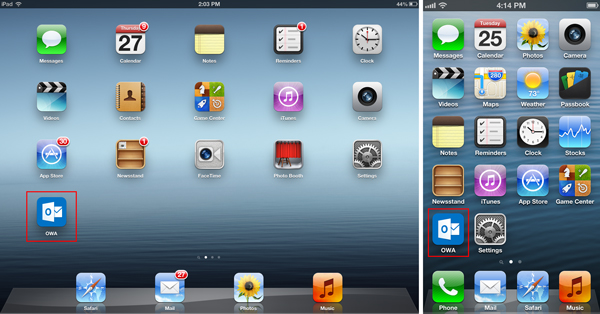
When you tap the icon, a sign-in screen opens where you can use your Office 365 credentials to connect to OWA.
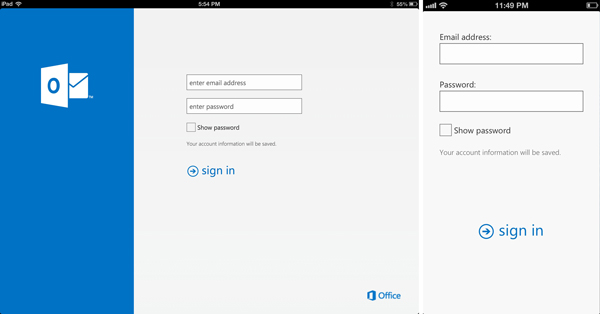
Navigation
Once signed in, you can switch between Mail, Calendar, People and Options by tapping on the icon in the bottom left corner of the app.

This takes you to a navigation screen with tiles you can tap to reach the desired module. Your upcoming meetings appear on the Calendar tile automatically!
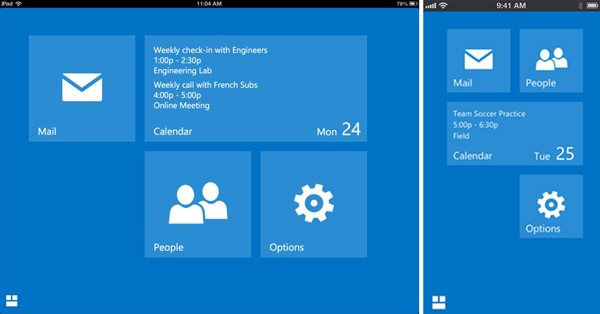
You can also tap and hold the icon at the bottom left corner of the app to start voice input.2

You then use your voice to tell the app to execute certain commands such as “Open calendar for tomorrow” or “New email to Katie Jordan.”

Inbox
When you receive new email, a red badge appears on the OWA icon to indicate the number of unseen new messages. As soon as you open the app and see the new email messages in the inbox, the badge will disappear from the icon on the home screen. The badge represents unseen messages, not unread ones.

The inbox in OWA for iPad defaults to a two-column view that shows the list view and reading pane with the folder pane collapsed. Meanwhile, the inbox in OWA for iPhone defaults to a one-column list view with controls to switch to the folder pane and reading pane. You’ll notice that the layout has been optimized for touch interaction with a user interface designed to respond to gestures like tapping and swiping.

A quick swipe of each list view item reveals a set of actions such as delete, flag, move and mark as read/unread. You can swipe multiple list view items to take action on all items at once. Swipe again to deselect an item.

Composing a new email is as simple as clicking the + icon on the top left corner of OWA for iPad and the bottom right corner of OWA for iPhone.

Tapping on the spectacles icon on the bottom right corner of OWA for iPad expands the reading pane to full screen to provide a more natural reading experience.
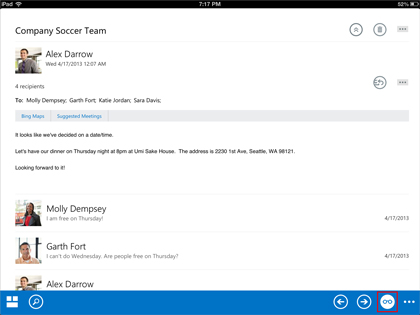
As with Outlook Web App in the browser, you can read and create Information Rights Management (IRM) protected email in OWA for iPhone and OWA for iPad. Also, out-of-office messages and other MailTips appear in the header of the compose form to notify you when you may want to think twice about sending an email message.

Even apps for Outlook work in OWA for iPhone and OWA for iPad. As you can see below, the app bar appears in the reading pane, and a simple tap on the Bing Maps app initiates an address search on Bing Maps directly from within OWA
 .
.
You can initiate a search by tapping on the magnifying glass icon at the bottom of the app. A search input will appear at the top of the list view in OWA for iPad and at the top of a new screen in OWA for iPhone. You can then type in a keyword to be searched within the inbox or filtered against People
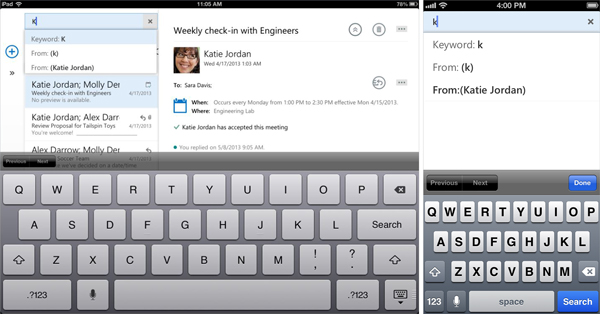 .
.
Finally, OWA for iPhone and OWA for iPad can be used in the absence of an internet connection. You can read, delete and flag messages, as well as compose new messages or reply to messages in your inbox. You can also view and edit your calendar and contacts. This offline capability is especially useful when you need to access your email on a flight with airplane mode turned on or on a train with intermittent network connectivity.
Calendar
The calendar in OWA for iPad is available in day, week, work week and month + agenda views. You can easily swipe from day-to-day, week-to-week or month-to-month, and you can tap on any calendar item to display a preview of the event details. The calendar in OWA for iPhone is available in day, month and agenda views. Categories are supported on calendar items, including the ability to assign categories and create new ones.


Composing a new calendar item or meeting request is as simple as tapping the + icon on the top left corner of OWA for iPad and the bottom right corner of OWA for iPhone.

From the event creation form in OWA for iPad, you have the option of launching the Scheduling Assistant, which gives you the ability to check the schedules of attendees, add attendees to the meeting and use the room finder to add a location to the meeting. You’ll notice that the Scheduling Assistant automatically indicates the free/busy status of each attendee, so you can quickly determine which time slots work best for the group.
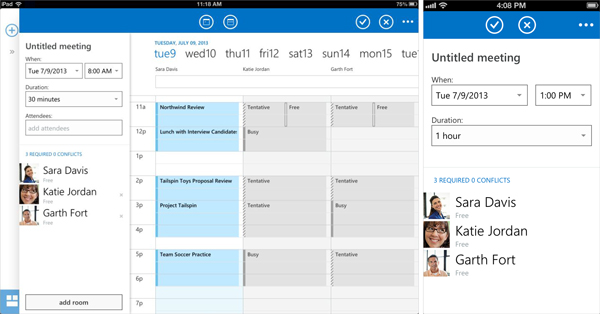
You can even add a location to a meeting directly from Bing Maps!
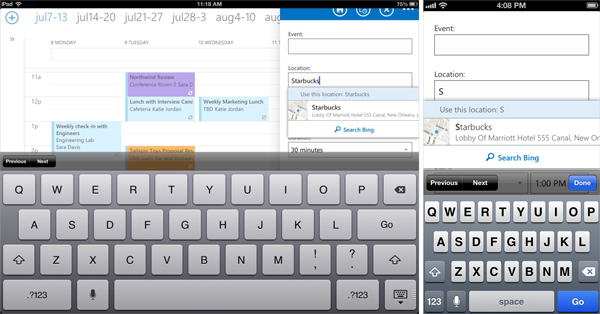
Finally, OWA for iPhone and OWA for iPad provide full delegate access to the calendar, as well as access to multiple and shared calendars. This is particularly important for supporting executive administrators and assistants.
People
If you navigate to People, you can access your contacts just as you do in Outlook Web App on the browser.

Your OWA contacts are automatically synced to the native address book on the device. One of the main advantages of doing this on your iPhone, for example, is that the caller ID function will be able to display the names of your OWA contacts when you receive phone calls from them. The ability for users to sync OWA contacts to the device can be controlled by IT at the organizational level.
Options
When you navigate to Options, you have additional controls at your disposal. For example, you can manage automatic replies and out-of-office messages, set your time zone and configure your email signature. You can also easily prevent OWA contacts from syncing to the device by unchecking the box under contact sync.
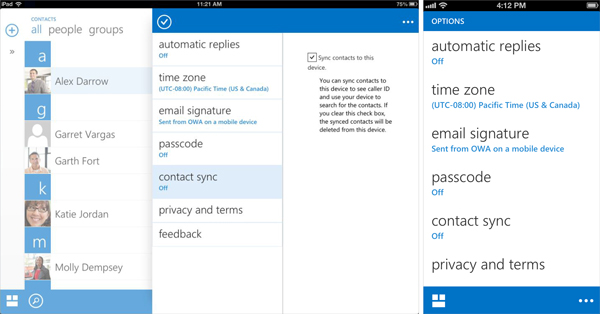
Administrators can manage their users’ access to OWA for iPhone and OWA for iPad through the Exchange Administration Center. They can initiate a remote wipe of the app on any connected device which will delete all email and calendar data contained in the app from the device.3 This is especially useful if the user leaves the organization, and IT wants to remove the email and calendar data from the device without compromising the user’s personal data.

Summary
As you can see, OWA brings all of the same benefits of Outlook Web App in the browser to your iPhone and iPad. In addition, it offers some capabilities only available through native integration with the device:
- Stored credentials so you are automatically logged into the app
- Push notifications that actively notify you of new email
- Meeting reminders that pop up even when the app is closed
- Voice activated actions like scheduling a meeting or sending email
- Contact sync so that OWA contacts are recognized by the iPhone’s caller ID function
- Remote wipe capability that allows IT to delete email and calendar data in the app from the device in the event that the device gets lost or the user leaves the organization
FAQ
Q: How do I get OWA on my iPhone or iPad?
A: Simply install “OWA for iPhone” or “OWA for iPad” from the Apple App Store. Once installed, you will need to sign-in using credentials from an Office 365 subscription that includes the latest update of Exchange Online.
Q: Do I need an Office 365 subscription to use OWA for iPhone and OWA for iPad?
A: Yes, an Office 365 subscription account with the latest update of Exchange Online1 is required to use OWA for iPhone and OWA for iPad.
Q: Will OWA for iPhone and OWA for iPad connect to Exchange Server 2013?
A: Yes, Exchange Server 2013 customers can use OWA for iPhone and OWA for iPad, but additional steps are required to configure push notifications. You can find more details in TechNet.
Q: How much does OWA for iPhone and OWA for iPad cost?
A: There is no additional charge for Office 365 subscribers. See below for details of those plans.
Q: What Office 365 subscription plans include OWA for iPhone and OWA for iPad?
A: Any Office 365 subscription plan that includes the latest update of Exchange Online also includes OWA for iPhone and OWA for iPad. Specifically, these plans are: Office 365 Small Business; Office 365 Small Business Premium; Office 365 Midsize Business; Office 365 Enterprise E1, E3 and E4; Office 365 Kiosk K1 and K2; Office 365 Education A2, A3 and A4; and any Exchange Online plan. There are also Office 365 government plans that include OWA for iPhone and OWA for iPad.
You will need to sign in to your Office 365 subscription on first run to activate OWA. If you aren’t already an Office 365 subscriber, you can visit www.office.com to learn more and sign up.
Q: What are the requirements to use OWA for iPhone and OWA for iPad?
A: There are two key requirements:
- First, you need an Office 365 subscription that includes the latest update of Exchange Online1 (see above for list). After you download OWA onto your iPhone or iPad, just sign in with your Office 365 credentials to get started.
- Second, you need an iPhone 4S or higher and an iPad 2 or higher. The device must also be running iOS 6 or higher.
Q: What happens if I cancel my Office 365 subscription but I’m using OWA for iPhone and OWA for iPad?
A: If your Office 365 subscription ends, you will no longer be able to access OWA from your iPhone or iPad. You can reactivate OWA by renewing your subscription and signing in with a valid user name.
Q: In what languages will you offer OWA for iPhone and OWA for iPad?
A: OWA for iPhone and OWA for iPad are available in the same 60 languages that are supported by Exchange Online for Outlook Web App in the browser. By default, the language in OWA for iPhone and OWA for iPad will be the same as the language in Outlook Web App in the browser. Actual time of availability in particular geographies will depend on when the latest update of Exchange Online becomes available in those markets. If you want to know if OWA for iPhone or OWA for iPad is available in your region, please check with your IT administrator to confirm.
We are excited to deliver this enhanced Outlook Web App experience for our Office 365 customers who are using iPhone and iPad at work, and we look forward to your feedback on how we can continue to meet your needs.
— Steve Chew
1 The new Office 365 announced in February 2013, which includes the latest update of Exchange Online, is required to use OWA for iPhone and OWA for iPad.
2 Voice input is only available in English (AU, CA, GB, IN, and US).
3 The app must be running on the device in order for it to be wiped remotely.




